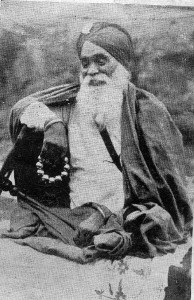 Naam Dhrir is a practice that is mostly unique to the Akhand Kirtani Jatha. It is when the Punj Pyareh during the Amrit Sanchaar ceremony teach the seeker of Amrit the technique of how to “Jap Naam” (recite the name of God). This practice is also referred to as “Swaas Swaas Simran”
Naam Dhrir is a practice that is mostly unique to the Akhand Kirtani Jatha. It is when the Punj Pyareh during the Amrit Sanchaar ceremony teach the seeker of Amrit the technique of how to “Jap Naam” (recite the name of God). This practice is also referred to as “Swaas Swaas Simran”
Gurbani talks about Swaas Swaas Simran time and time again. There are many shabads, for example:
ਸਾਸ ਸਾਸ ਸਾਸ ਹੈ ਜੇਤੇ ਮੈ ਗੁਰਮਤਿ ਨਾਮੁ ਸਮ੍ਹ੍ਹਾਰੇ ॥
ਸਾਸੁ ਸਾਸੁ ਜਾਇ ਨਾਮੈ ਬਿਨੁ ਸੋ ਬਿਰਥਾ ਸਾਸੁ ਬਿਕਾਰੇ ॥੭॥
“With as many breaths as I have, I chant the Naam, under Guru’s Instructions. Each and every breath which escapes me without the Naam – that breath is useless and corrupt. ||7||”
(SGGS – Ang 980)
Gurbani says “Gurmat Naam”, meaning Naam in accordance to the Guru’s instructions. So what are the Guru’s instructions? This is discovered at the Amrit Sanchaar. However, sadly the reality today is that people take Amrit and then ask others like Sants and Holy men “How do we Jap Naam?” They should not ask others. The Guru is Great. If the Guru gives GurMantar then he also has given a technique of how to Jap it.
Gurmat Naam is bestowed to the Sikh when one receives Amrit from the Panj Piyaare (5 initiated Sikhs who are the physical representation of the Guru) in the presence of Sri Guru Granth Sahib Ji. Gurbani gives the hints that when a seeker receives Naam from the Guru in the form of the Panj Pyaare then the Panj Pyaare place their hands on the head of seeker and make the devotee repeat Naam:
ਮੇਰੈ ਹੀਅਰੈ ਰਤਨੁ ਨਾਮੁ ਹਰਿ ਬਸਿਆ ਗੁਰਿ ਹਾਥੁ ਧਰਿਓ ਮੇਰੈ ਮਾਥਾ ॥
ਜਨਮ ਜਨਮ ਕੇ ਕਿਲਬਿਖ ਦੁਖ ਉਤਰੇ ਗੁਰਿ ਨਾਮੁ ਦੀਓ ਰਿਨੁ ਲਾਥਾ ॥੧॥
“(When) the Guru placed His hand on my forehead, the Jewel of the Lord’s Name came to abide within my heart. (Whoever) the Guru has blesses with Naam, the Name of the Lord, their sins and pains of countless incarnations are cast out and the debt (of sins) is paid off. ||1||”
(SGGS – Ang 696)
ਸਮਰਥ ਗੁਰੂ ਸਿਰਿ ਹਥੁ ਧਰ੍ਯ੍ਯਉ ॥
ਗੁਰਿ ਕੀਨੀ ਕ੍ਰਿਪਾ ਹਰਿ ਨਾਮੁ ਦੀਅਉ ਜਿਸੁ ਦੇਖਿ ਚਰੰਨ ਅਘੰਨ ਹਰ੍ਯ੍ਯਉ ॥
“The All-powerful Guru placed His hand upon my head. The Guru was kind, and blessed me with the Lord’s Name. Gazing upon His Feet, my sins were dispelled.”
(SGGS – Ang 1300)
ਮੈ ਸੁਖੀ ਹੂੰ ਸੁਖੁ ਪਾਇਆ ॥
ਗੁਰਿ ਅੰਤਰਿ ਸਬਦੁ ਵਸਾਇਆ ॥
ਸਤਿਗੁਰਿ ਪੁਰਖਿ ਵਿਖਾਲਿਆ ਮਸਤਕਿ ਧਰਿ ਕੈ ਹਥੁ ਜੀਉ ॥੯॥
“I have obtained the comfort of spiritual comforts. The Guru has implanted the Word of the Shabad deep within me. The True Guru has shown me my Husband Lord when He has placed His Hand upon my forehead. ||9||”
(SGGS – Ang 73)
Bhai Chaupa Singh Ji, contemporary of Guru Gobind Singh Jee, records the 10th Guru’s instruction in his Rehatnama:
ਗੁਰੂ ਕਾ ਸਿਖ ਸਾਸ ਸਾਸ ਵਾਹਿਗੁਰੂ ਉਚਾਰ ਕਰਦਾ ਰਹੈ ॥
“The Guru’s Sikh with each and every breath (‘Saas Saas’) should keep uttering ‘Vaheguru’.”
(p. 105, Piara Singh Padam – ‘Rehatnamay’)
Naam Dhrir was a concept that was lost in much of the Panth but was preserved in some places. Prem Sumaarag Granth, an old puraatan rehitnama describes it in the 4th dhiaaai or section. Bhai Mani Singh’s bhagat ratnaavalee describes how Guru Nanak did Naam Dhrir on two Sikhs when they were initiated. The Sau Sakhee also mentions how Guru Gobind Singh taught this method. The book “Jeevan Sant Baba Attar Singh jee” by Sant Teja Singh MA has a section on “naam” which gives historical details on Naam Dhrir. Sant Teja Singh was a prominent Sikh leader and a close associate of Sant Attar Singh Jee. In the book, Sant Teja Singh writes the following:
“The method of reciting naam (naam japan dee jugath) has been passed down from Gursikh to Gursikh. But this daas has only seen it written in two places. In Sau Sakhi its says that Guru Gobind Singh Ji Maharaj tells Mata Jeetho Ji that the tip of the tounge (jeeb di teesy), with force (jOr naal), should touch the roof of the mouth (thaloo naal), and at all times keep saying Waheguru Waheguru.
Shaheed Bhai Mani Singh, the one who sat and listened to the recitation of Sri Guru Granth Sahib Ji by Sri Guru Gobind Singh himself, in Bhai Gurdas Ji’s ‘yarwee waar’ in ‘sheeha thay gajan dee sakhee’, has written that when our breath goes in we should say ‘Wahe’ and when our breath goes out we should say ‘guru'”
Through this method, Naam vibrates through every pore of one’s being and brings one closer to the blessed Darshan of Vaheguru. It is ideal to engage in naam abhyaas in the transformative environment of sadhsangat. Only with the Guru’s grace does this opportunity arise.